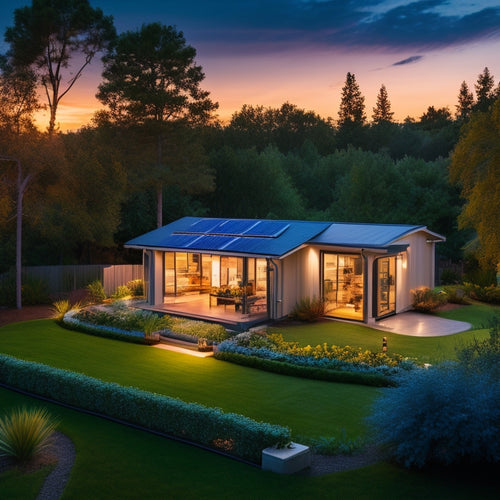
Why Aren't Solar Power Installation Costs Dropping Faster?
Share
You've likely noticed that despite a 70% drop in solar panel prices over the last decade, the overall cost of solar power installation hasn't followed suit. The culprit lies in several areas, including soft costs like financing, permits, and labor, which account for a significant portion of expenses. Supply chain inefficiencies, slow technology advancements, and policy and regulation obstacles also contribute to the stagnation. Additionally, industry growth and competition forces impact installation costs. As you investigate these intricacies, you'll reveal the subtleties driving solar installation costs and identify opportunities for improvement, revealing a path forward to making solar power more accessible.
Key Takeaways
- Soft costs, including permits and labor, account for a significant portion of overall solar installation expenses, hindering cost reductions.
- Supply chain inefficiencies, such as long lead times and high logistics costs, contribute to elevated installation costs.
- Slow technology advancements due to plateaued research funding and lack of innovation hinder significant cost drops in installations.
- Complex and inconsistent policy and regulation hurdles, including permits and interconnection standards, drive up costs and slow project timelines.
- Industry growth and competition dynamics, including market saturation and prioritization of premium products, limit the potential for rapid cost reductions.
Soft Costs Remain a Barrier
As the solar industry continues to grow, soft costs remain a significant obstacle to widespread adoption. You're likely aware that the cost of solar panels themselves has decreased dramatically over the years. However, the "soft costs" associated with installation, such as permits, inspections, and labor, haven't followed suit. In fact, these costs now account for a significant portion of the overall price tag.
One major contributor to soft costs is the lack of financing options for consumers. You may find that securing a loan or financing for a solar installation is more complicated than you anticipated. This can lead to higher costs and longer project timelines.
Additionally, a lack of consumer education on the solar installation process can also drive up costs. Without a clear understanding of the process, you may be more likely to encounter unexpected delays or expenses.
To address these soft costs, the industry must prioritize consumer education and develop more accessible financing options. By doing so, you'll be able to take advantage of the benefits of solar power without breaking the bank.
Supply Chain Inefficiencies Persist
You've likely noticed that while the cost of solar panels has decreased, the overall cost of installation remains high. This disparity is largely due to supply chain inefficiencies that persist in the solar power industry. Manufacturing bottlenecks and material shortages continue to plague the sector, driving up costs and hindering the adoption of solar energy.
Some of the key supply chain inefficiencies include:
-
Long lead times: Delays in the production and delivery of solar panels and other components lead to increased costs and project timelines.
-
High logistics costs: The transportation of bulky and heavy solar equipment from manufacturing facilities to installation sites adds to the overall cost of installation.
-
Inefficient distribution networks: The lack of optimized distribution channels results in higher costs for storage, handling, and inventory management.
These inefficiencies not only drive up costs but also limit the scalability of solar power installations, making it challenging to meet the growing demand for renewable energy.
Addressing these supply chain inefficiencies is essential to reducing the overall cost of solar power installation and accelerating the shift to a low-carbon economy.
Technology Advancements Slow Down
Slowing down in recent years, technology advancements in the solar power industry have failed to keep pace with the rapid growth in demand, further exacerbating the high cost of installation. You might expect innovation rates to accelerate as the industry grows, but that's not the case. Research funding, a key driver of innovation, has plateaued, and the industry is feeling the effects.
| Year | Research Funding (millions USD) |
|---|---|
| 2015 | 250 |
| 2018 | 300 |
| 2020 | 305 |
As a result, the industry is struggling to achieve the economies of scale needed to drive down costs. You're not seeing the same level of investment in R&D as you did in the early days of solar power. This slowdown in innovation means that installation costs are remaining stubbornly high. Without a resurgence in research funding and innovation, it's unlikely that installation costs will drop considerably anytime soon.
Policy and Regulation Hurdles
The industry's regulatory environment is a minefield of policy and regulation barriers that hinder the adoption of solar power, further driving up installation costs.
You face a complex web of rules, permits, and incentives that vary by state, locality, and even utility company. This fragmentation creates uncertainty, making it difficult for you to maneuver through the system and increasing the costs of regulatory compliance.
To make matters worse, incentive programs designed to promote solar adoption often have strings attached, such as caps on funding or Byzantine application processes.
This red tape slows down project timelines, adds to your overhead, and reduces the competitiveness of solar power.
Some of the key policy and regulation obstacles you need to overcome include:
- Interconnection standards: Varying rules for connecting solar systems to the grid create confusion and drive up costs.
- Net metering laws: Inconsistent policies on how to credit excess energy production hinder the financial viability of solar projects.
- Tax credits and grants: Complexity in accessing these incentives can lead to delays and increased expenses.
Industry Growth and Competition
As the regulatory environment continues to evolve, the solar power industry's growth and competition interactions are also shaping installation costs. You may expect that as the industry grows, competition would drive prices down. However, the reality is more complex.
In many markets, solar power is approaching market saturation, where the number of potential customers is dwindling. This shift is altering pricing strategies, as companies focus on retaining market share rather than expanding their customer base.
In this environment, companies are less inclined to reduce prices, as they prioritize profit margins over market growth. You're seeing companies focus on differentiating themselves through premium products, advanced technologies, or exceptional customer service, rather than undercutting their competitors on price.
While this shift may not lead to the price drops you'd expect, it's driving innovation and improving the overall quality of solar power installations. As the industry continues to mature, it's crucial to understand these competitive interactions to accurately forecast installation costs.
Frequently Asked Questions
Are Solar Panels Getting More Efficient in Converting Sunlight to Electricity?
You're witnessing solar technology advancements firsthand, as photovoltaic efficiency trends show a steady increase in converting sunlight to electricity, with top-performing panels now reaching efficiencies of over 26%, and experts predicting even higher rates in the near future.
Can I Install Solar Panels Myself to Save on Labor Costs?
Installing solar panels yourself is like steering through a complex puzzle, requiring precision and patience. While a DIY installation can bring cost savings, you'll need to evaluate permits, electrical connections, and warranties, making it a challenging task even for the handy.
Are There Any Government Incentives for Solar Power Installation?
You're eligible for federal tax credits, covering up to 26% of your solar installation costs, and state rebates, which vary by location, to offset expenses; research and claim these incentives to maximize your solar power investment.
Can Solar Power Systems Be Used for Heating Water and Homes?
You can utilize solar power to heat water and homes through solar water heating, achieving higher thermal efficiency than traditional systems, and reducing your reliance on fossil fuels.
How Long Does It Take for Solar Panels to Pay for Themselves?
"Time is money," and you're wondering when your solar panels will start saving you cash. On average, it takes 5-7 years for solar savings to cover the initial investment, known as the payback period, depending on your energy usage and local incentives.
Conclusion
As you've seen, the solar power installation cost curve isn't dropping as rapidly as expected. Coincidentally, it's the same soft costs, supply chain inefficiencies, and policy barriers that have been hindering progress for years. Technology advancements, once the driving force behind cost reductions, have slowed. Meanwhile, industry growth and competition have yet to translate into significant savings. It's a perfect storm of stagnation, and it's up to stakeholders to address these persistent challenges to release the full potential of solar energy.
Related Posts
-

Energy-Efficient Lighting Solutions for Sustainable Buildings
For sustainable buildings, energy-efficient lighting solutions, like LEDs, offer multiple benefits. These bulbs last ...
-

Solar Power Backup Solutions During Outages
Solar power backup solutions guarantee you have reliable energy during outages, providing essential power when the gr...
-

Integrating Smart Technology for Energy Savings
Integrating smart technology into your home is a transformative factor for energy savings. Smart thermostats give you...


